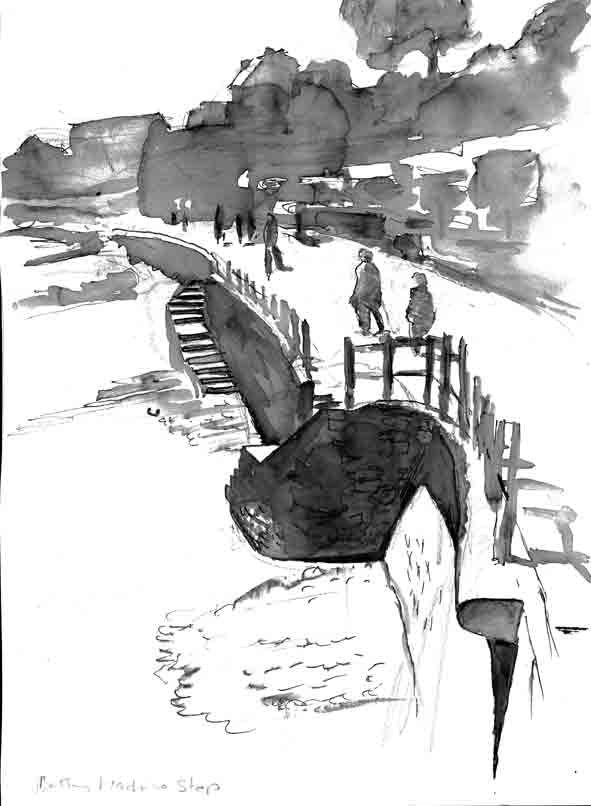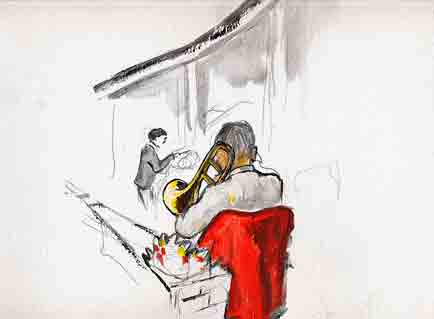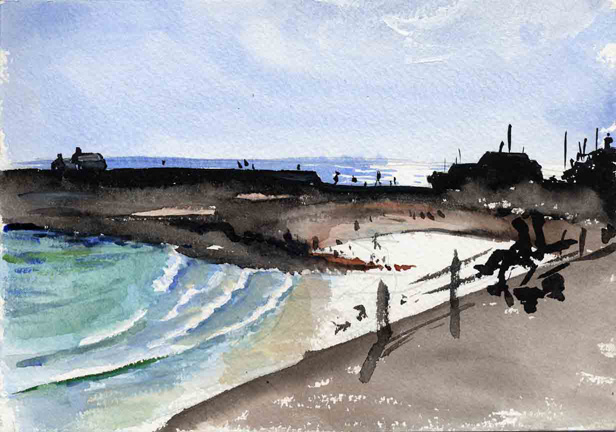|
Past the Bay Hotel, the Walk, or upper level of Marine Parade, continues westward.
The lower level, the Cart Road, doesn't — or didn't until the
plan to extend the Cart Road in 2005. So here was where the waves
delivered their punches right to the concrete wall below you, and
on windy days you could play at standing to the railing and then
scuttling back before the spray showered down on you.
When the tide was
lower you could get down to the beach by two more sets of steps,
facing each other (later mostly buried under the extended Cart Road).
One or both of these, I'm not sure which, used to be called the
Bathing Machine Steps because
this part of the beach was where, in the nineteenth century, those
prudish contraptions were deployed.

Up to the right
now is a steep grassy hillside, but structures continue along its
foot, with the purpose of holding its “toe” against slippage.
There is a long shallow shelter where on Tuesday evenings of July
and August the town band plays.

But the best use of this rather strange concrete embayment is that
made by boys on skateboards.
The next stretch
is even more strange: its centrepiece is an apparent ceremonial
portal with a war-memorial clock over it, but this and the arcades
on either side are all boarded up. (Deck chairs, I think, are stored
in the cavernous space within.) Then a blank white wall on which,
each July during carnival week, children paint a mural — hundreds
of little individual pictures in primary colours. Even from out
at sea it looks good, harmonizing with the large mural painting
that is the slopeside town itself. But each September the wall is
whitewashed over, by order of the town council. You can dimly see
the children's hieroglyphs through the official whitewash.
(Footnote: the council
must have relented to comments like that. The bright graffiti are
still there in December, untarnished by weather; they aren't whitewashed
over till spring.)
And in front on
the tarmac, until erased by rains, you can see six hundred rectangles
delineated with white chalk, in each of which a child has been allowed
to make a drawing: airplanes, ducks, suns, flags, muscles. This
isn't, of course, a spontaneous outburst of expression — the
white rectangles already give that away — and it disappoints
me a bit more to see that some have been marked “1st prize,”
“2nd,” “3rd.“..
The grassy slope
above, reached in several places by stairways, is seamed with paths,
the lowest of which runs along on the tops of the slope-foot structures,
partly on a concrete-legged flyover. Then come an amusement arcade
and some places of refreshment, ending with the By the Bay restaurant,
with tables out in front for the views over beach and coast.

You're almost at
your goal: only a few yards ahead is the cluster of buildings called
the Cobb village, at the landward base of the Cobb itself. Entering
the village, the Walk ceases to be just a Walk (as is signalled
by a barrier to wheeled vehicles) and becomes a narrow street, though
ambling pedestrians still fill it and are surprised to see even
a bicycle coming along.
The first building
on the left, now Jane's Café, was formerly Bay Cottage. In Jane
Austen's Persuasion, it was the house where Captain Harville
lived. About opposite to it was a house where Jane Austen and her
family may have stayed in 1803 or 1804. The site is now the Jane
Austen Garden. You can go up into it by flights
of steps.
After the garden,
the first structure standing on the right is a high hoarding, hiding
a space at the foot of the hill and bearing a long proclamation:
What you're looking at could happen to your property. The ruins
behind this board were once homes and also businesses. They were
evacuated and blocked up under a law that empowers any local authority
in the country to do likewise to any buildings it one-sidedly judges
a public danger, forcing their owners to pay the costs.
Here the authority's
initial bill came to £67,955. In addition the owners must jointly
pay £175 a week for hire of the scaffolding used in making their
properties worthless. The hire-charge could go on for ever because
the owners are forbidden to demolish the buildings.
The reason is that
the authority fears that knocking them down would set off a landslip.
But the reason they were blocked up originally is that the authority
feared a landslip would knock them down. What's more, because they
were blocked up before a landslip hit them, the owners' insurance
companies won't pay up on their policies against landslip.
It's a crazy nightmare
that could suddenly come true for you too. Though you may think
your home is your castle, the law says otherwise. And it doesn't
take landslips or flooding to trigger Section 78 of the Building
Act 1984 which empowers local authorities to trash properties abutting
on public places. A one-off geological flaw hidden under your home
or business would be quite enough.
So if you'd like
to help yourselves as well as us, when candidates ask for your vote
in the general election, demand their pledge that if they win they
will press for the unjust law to be changed.
More details
can be obtained from the Safeguard Lyme's Interest Party at Lyme
Potters across the road or the Antiques Centre or Amusement Arcade
along to the right.
This grievance-notice is something of a tourist attraction. You're
not the first to come to a standstill and stare up at it.
But you're the last!
The hoarding suddenly groans, totters, and splinters toward you.
You scream and scramble back, to the safety of the Walk. What you
are witnessing is a smart example of a Lyme landslip! Hillside and
houses come tumbling, until the street is blocked. Well, not quite;
the glacis of rubble and mud isn't that high, you could pick your
way over it. But you aren't allowed to: a swarm of authorities in
yellow jackets and hard hats has already arrived and cordoned it
off. You watch their activities for a while, but they're not yet
in a mood to answer your questions about landslips.
Back
you'll have to go, and find some other way around to the Cobb.
(Footnote: the grievance-notice
was removed about September 2004. The council had come to some agreement
with the owners and taken over the land.. The ground having been
stabilised, in 2010 someone bought the site for development.)
|



